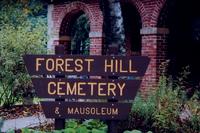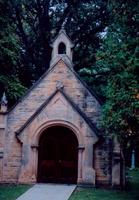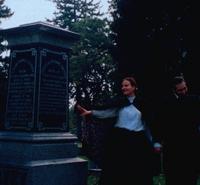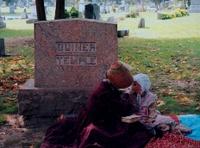 Sunday , October 2 was an unusual autumn day -- the temperature reached a record 85F, making it seem more like the 'dogs days of summer' than a month before Halloween. If not for the cool shade of trees planted more than a century ago, it would have made the seventh annual “Talking Spirits” tour unbearable.
Sunday , October 2 was an unusual autumn day -- the temperature reached a record 85F, making it seem more like the 'dogs days of summer' than a month before Halloween. If not for the cool shade of trees planted more than a century ago, it would have made the seventh annual “Talking Spirits” tour unbearable."Talking Spirits" is a living history event at Forest Hill Cemetery in Madison sponsored by the Wisconsin Veterans Museum. During the two-hour walk through the ancient cemetery, guides tell about the cemetery and city’s history, point out interesting headstones as well as those of prominent Madisonians, and explain the significance of different styles and design elements used in the many stones. Along the way visitors meet a variety of “spirits” who tell their personal stories and experiences during different wars in American history.
Earlier residents of Madison were buried in various locations and small churchyard cemeteries around the city. Within only a few years it was obvious that a larger plot was needed to meet the needs of a growing city, and land was puchased 2-1/2 miles west of the city in March 1858. Bodies were removed from different locales around town, as well as the village cemetery, beginning in September 1859. Though burials continued at the old village cemetery until June 1866, all were eventually removed and the site of the original village cemetery then became Orton Park. Forest Hill now covers about 140 acres and contains more than 32,000 graves. The cemetery is now considered to be nearly full, however, original land agreements indicate that they may have the option of annexing land from the neighboring golf course.
Around the turn of the century, families frequently packed picnic lunches and rode the trolley out to the cemetery on Sundays, srolling through the peaceful setting, thinking about the past and future, and keeping a little bit of history alive for themselves. Today, there are benches scattered throughout the cemetery as a means of encouraging people to enjoy the parklike setting. Perhaps not a locale most would choose to walk or sit, or even enjoy a picnic linch, but it does have the advantage of few (living) people to distract or interrupt, and is quite peaceful despite the heavy traffic roaring down Speedway Road.
 The tour began at the Catlin Chapel, which sits just inside the main gates and was donated to the cemetery by the family of John Catlin in 1878. The chapel is quite small, with a tiny pulpit only a few paces across from the door, and three rows of pews on either side, facing the center of the chapel.
The tour began at the Catlin Chapel, which sits just inside the main gates and was donated to the cemetery by the family of John Catlin in 1878. The chapel is quite small, with a tiny pulpit only a few paces across from the door, and three rows of pews on either side, facing the center of the chapel. Across from the chapel is the old Receiving Vault, which was used to store coffins over winter months, back before they had machines to dig the graves. It is no longer used in this capacity, but may still be used for storage.
Across from the chapel is the old Receiving Vault, which was used to store coffins over winter months, back before they had machines to dig the graves. It is no longer used in this capacity, but may still be used for storage.We then began our walk through the grounds, our guide stopping now and then to point out the marker of a famous Madisonian – Vilas, Atwood, Babcock – or interesting headstone. There is a wide variety in style and design employed in the cemetery’s headstones. Many go for a more “traditional” look, or a flat marker laid atop their resting spot; others use natural influence or sport an art deco design. I tried to get pictures of the different “spirits,” but it was difficult to do amid the crowd and so I am missing two of the actors. A third was absent due to illness.
 Our first stop on this year’s tour was the marker of Governor Louis Harvey (1820-1862) and wife Cordelia Harvey Chester (1824-1895). Harvey was the seventh governor of Wisconsin, and in April of 1862, traveled south to view troops following the Battle of Shiloh. It was on the return trip that he slipped on the deck of his steamboat, fell overboard, and drowned. Not at all an illustrious way to go. He was appalled at the conditions he found and said as much in his final letter to his wife, which she received a week after his death.
Our first stop on this year’s tour was the marker of Governor Louis Harvey (1820-1862) and wife Cordelia Harvey Chester (1824-1895). Harvey was the seventh governor of Wisconsin, and in April of 1862, traveled south to view troops following the Battle of Shiloh. It was on the return trip that he slipped on the deck of his steamboat, fell overboard, and drowned. Not at all an illustrious way to go. He was appalled at the conditions he found and said as much in his final letter to his wife, which she received a week after his death.Inspired by her husband’s last letter, Cordelia became the state sanitary agent, petitioning President Lincoln in a personal visit to the White House to build a Union hospital in the north. She argued that troops would heal faster and be more willing to continue the fight if they could recuperate in clean, friendly hospitals rather than languish in fetid conditions in southern hospitals where many died not of their wounds, but disease, malnutrition and neglect. A hospital was created for Wisconsin Union veterans, and another home was later created for the orphaned children of soldiers. (Portrayed by Scott Feiner and Fran Lyons.)
 Emily C. Quiner (1840-1919) was a schoolteacher in Madison where her father, Edwin Quiner, was a well-known newspaperman and Civil War historian (Wisconsin in the War of the Rebellion). She began keeping a journal when the war broke out in 1861, detailing her life in Madison and subsequent experiences as a nurse caring for Union troops at a Memphis hospital. (Portrayed by Liz Angle; Destiny Sabljak played her student.)
Emily C. Quiner (1840-1919) was a schoolteacher in Madison where her father, Edwin Quiner, was a well-known newspaperman and Civil War historian (Wisconsin in the War of the Rebellion). She began keeping a journal when the war broke out in 1861, detailing her life in Madison and subsequent experiences as a nurse caring for Union troops at a Memphis hospital. (Portrayed by Liz Angle; Destiny Sabljak played her student.)




No comments:
Post a Comment